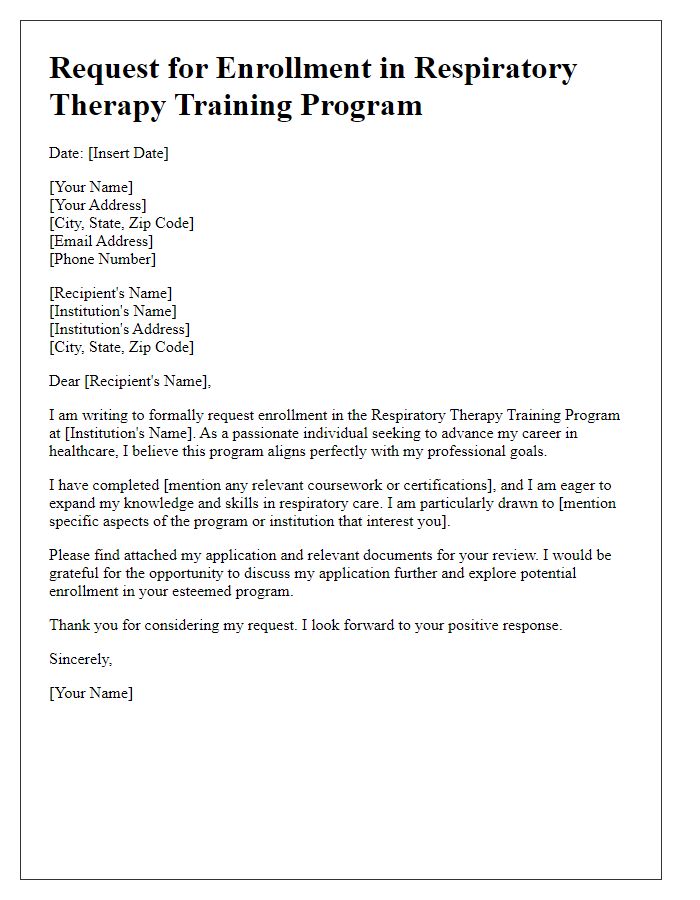Are you considering a rewarding career in healthcare? Enrolling in a respiratory therapy program can open doors to a world of healing and support for patients battling respiratory issues. With hands-on training and a growing demand for skilled professionals, this field offers both job security and personal fulfillment. If you're curious about what it takes to start your journey in respiratory therapy, read on to discover how you can make a difference!

Applicant's Personal Information
Respiratory therapy programs aim to train professionals who assist patients with respiratory issues. Applicants must provide personal details, including full name, date of birth, and contact information (phone number and email address), essential for identification and communication. Additionally, applicants should include their educational background, listing schools attended, dates of attendance, and degrees earned, as this information is crucial for assessing qualifications. Also, relevant work experience in healthcare or related fields, along with certifications such as CPR (Cardiopulmonary Resuscitation) or BLS (Basic Life Support), may enhance the application. Personal statements detailing motivation for pursuing respiratory therapy and future career aspirations can also strengthen an application.
Program's Admission Requirements
The admission requirements for respiratory therapy programs are crucial for aspiring healthcare professionals. Typically, applicants must possess a high school diploma or equivalent (GED), with coursework in biology, chemistry, and mathematics, reflecting a solid academic foundation. Standardized test scores (such as the ACT or SAT) may be required, depending on the institution, demonstrating college readiness. Furthermore, applicants often need to submit official transcripts from previous educational institutions (high school and any college courses) to verify academic performance. Letters of recommendation (usually from educators or healthcare professionals) are often encouraged to provide insight into the applicant's character and suitability for the healthcare field. Additionally, a personal statement or essay outlining motivation and career goals in respiratory therapy, specifically detailing experiences in patient care or exposure to the respiratory healthcare environment, can strengthen the application. Completion of any prerequisite courses (such as anatomy or physiology) is sometimes mandated before admission consideration. Lastly, many programs may also require an interview process, allowing applicants to demonstrate their passion and commitment toward a career in respiratory therapy.
Statement of Intent or Purpose
The enrollment in respiratory therapy programs illustrates a commitment to enhancing patient care, particularly in hospitals and clinics. Respiratory therapists play a critical role in managing respiratory diseases such as chronic obstructive pulmonary disease (COPD) and asthma, which affect millions globally. In the United States, approximately 30 million adults suffer from asthma, highlighting the necessity for skilled professionals. The respiratory therapy curriculum typically encompasses coursework in human anatomy, patient assessment, and ventilator management, essential for effective treatment plans. Furthermore, clinical practicum experiences provide hands-on training in diverse environments, including emergency rooms and rehabilitation facilities. Undertaking a respiratory therapy program not only fosters professional growth but also contributes to improved health outcomes for individuals struggling with respiratory challenges.
Relevant Experience and Qualifications
Aspiring respiratory therapists exhibit a solid background in healthcare, underscored by various relevant experiences and qualifications. Many candidates hold a degree in respiratory therapy from accredited institutions, such as the Commission on Accreditation for Respiratory Care (CoARC) accredited programs. Clinical rotations within hospitals, particularly those specializing in pulmonary care, offer hands-on training in patient assessment and the use of mechanical ventilation systems, essential for treating conditions like Chronic Obstructive Pulmonary Disease (COPD) and pneumonia. In addition, certifications from the National Board for Respiratory Care (NBRC), such as the Certified Respiratory Therapist (CRT) and Registered Respiratory Therapist (RRT) credentials, signify a comprehensive understanding of the field and commitment to ongoing education. Proficiency in interpreting arterial blood gases (ABG) and familiarity with advanced life support protocols enhance the skill set necessary for effective patient care. Participation in workshops and seminars, focusing on the latest advancements in respiratory therapies and technology, further demonstrates dedication to professional growth within the evolving landscape of respiratory health.
Contact Information for Inquiries and Submission
Respiratory therapy programs require prospective students to submit an application and supporting documents to specific contact points. Key institutions, such as community colleges and universities, often provide dedicated contact information for program inquiries. Potential applicants should confirm details on official websites. Submission methods may include electronic formats (PDFs) via email or physical copies sent to administrative offices. Program coordinators often provide guidance on prerequisites (such as a background in biology or healthcare). Additionally, prospective students should be aware of application deadlines, typically occurring between December and February for fall enrollment, with earlier dates for scholarship opportunities.
Letter Template For Respiratory Therapy Enrollment Samples
Letter template of application for respiratory therapy program enrollment

Letter template of inquiry regarding respiratory therapy program registration

Letter template of enrollment application for respiratory therapy certification

Letter template of formal request for respiratory therapy training enrollment

Letter template of confirmation of enrollment in respiratory therapy program

Letter template of admission application for respiratory therapy technician program

Letter template of justification for enrollment in respiratory therapy classes







Comments